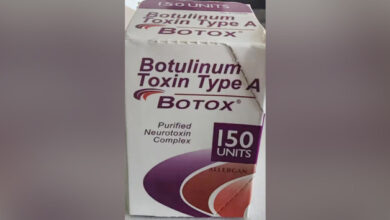EtO gas used to sterilize medical devices ignites fears over link to cancer

(NEW YORK) — After years of holding community meetings and knocking on doors, community activists are now seeing action about an invisible risk raising concerns about cancer in their communities.
A recently announced rule from the Environmental Protection Agency would reduce an estimated 90% of ethylene oxide emissions from the facilities that use it. Ethylene oxide is a colorless and odorless gas that is considered essential for sterilizing medical devices but also has been linked to cancer risk for people breathing in significant amounts of it over time.
Around 20 billion medical devices used in the United States, including ventilators, syringes and catheters, are sterilized with ethylene oxide (EtO) every year.
“Ethylene oxide is the most widely used, safe and effective, scientifically proven modality for medical device sterilization not only in the United States, but worldwide,” said Dr. Suzanne Schwartz, director of the Office of Strategic Partnerships and Technology Innovation at the Center for Devices and Radiological Health at the U.S. Food and Drug Administration.
While there is no known risk to doctors and patients using the EtO-sterilized devices, the Environmental Protection Agency (EPA) announced in 2022 that long-term exposure to the gas emissions from facilities can increase the risk of cancers including lymphoma, leukemia, stomach and breast cancers.
There are 88 facilities that use EtO to sterilize medical equipment all around the country in 32 states and Puerto Rico. Some residents nearby fear that the emissions that escape these facilities could be threatening their health.
The new EPA rule comes after years of activism from residents in communities that were notified the amount of EtO they could be exposed to posed a risk of cancer that the EPA considered concerning.
In South Memphis, Tennessee, the Mallory Heights Community Development Corporation has been raising awareness of the potential hidden danger of EtO emissions in their neighborhood.
“So many people that I know within my family and live in this area have died of cancer or have cancer now,” Vera Holmes, president of the Mallory Heights CDC, told ABC News’ Nightline.
While scientists say it is nearly impossible to link any one person’s cancer to EtO, local residents raise concerns about their cancer diagnoses being related. Ural Grant, who has lived in South Memphis for more than 35 years, was diagnosed with Stage 4 colon cancer in 2019. He says that many of his neighbors also have cancer.
“I thought this was my American dream right here to have a home, to have a house,” Grant said. “But then it kind of turned into an American nightmare.”
Grant says he cannot afford to move due to mounting medical bills. Similarly, many of those impacted by EtO emission live in working-class neighborhoods.
KeShaun Pearson, president of Memphis Community Against Pollution, believes that racial injustice is at play when toxic gas emission happens in predominantly Black neighborhoods.
“[Memphis] as a whole has an F in air pollutants and in air quality, and 98% of the particular matter that makes up the pollution is here in South Memphis,” Pearson said. “That is not coincidental. That is by design. It’s been designed that this area specifically is a place where people’s lives can be sacrificed.”
In Laredo, Texas, residents face a similar battle. The border town is home to a population of about 250,000 people, mostly working-class and Hispanic.
“This is one of the largest warehousing areas in the city,” said Victor Trevino Jr., a local attorney who has lived in this town all his life. “We have residential areas right next to this industrial area within a couple of miles.”
Among the industrial facilities nearby, Midwest Sterilization Corporation has been in operation since 2005. Up to 40% of all the nation’s sterilization kits are sterilized in this location.
“Laredo has a 95% Hispanic population. We have one of the highest poverty rates in the state,” Trevino said. “This is really a crisis for us at this point.”
Victor’s father, Dr. Victor Trevino Sr., has worked as a physician in the community for around 40 years. He also served as the health authority before his current role as mayor of Laredo. He says it’s important to balance the need for employment with safety.
“It employs a significant amount of people, and employment is good for a community,” Dr. Trevino Sr. said to Nightline. “But we also have to say, ‘at what cost?’”
Despite the plant being built in 1976, many residents living just minutes from Midwest Sterilization say that they have no idea the plant was even there.
“We have always been in compliance with state and federal regulations and continue to be,” Midwest Sterilization Corporation said in a statement to ABC News. “Our top priority is ensuring that we can continue to keep communities safe while helping to save patients’ lives. We are firmly committed to doing everything possible to continue to reduce emissions and keep Laredoans safe.”
Now, changes are happening on a federal level.
For the first time in 50 years, the EPA released new rules for commercial sterilization that uses EtO, aiming to reduce emission by more than 90%. Under the new regulation, facilities will have to implement major changes including pollution control, ventilation systems, and increased monitoring and reporting.
EPA Administrator Michael Regan said in a statement that the agency listened to impacted communities in drafting a rule to protect their health.
“We’ve arrived at a historically strong rule that will protect the most exposed communities from toxic air pollution while also ensuring that there will be a process that safeguards our nation’s critical supply of sterilized medical equipment,” Regan said.
Scott Whitaker, the CEO of AdvaMed, a group that represents sterilization facilities, spoke about potential changes during a House of Representatives Energy and Commerce Committee hearing.
“We’ve made it clear that we welcome updated regulations. After all, our industry’s commitment to saving and improving lives does not end where sterilization begins,” Whitaker said. “How regulators implement this updated rule is critical to ensuring that there is (1) no disruption to the medical supply chain and (2) no harm to patients, and that (3) the communities surrounding these facilities remain safe.”
While AdvaMed added in a statement that they have worked with the FDA and the EPA to ensure the final rule would “enhance and not hinder” their company’s “already-well-established commitment” to safe sterilization, the facilities could take two, three years or longer to comply with the new rule.
The FDA emphasizes the importance to balance reducing emissions while not jeopardizing the medical device supply chain.
“It is not a zero-sum game,” Schwartz said. “We have to be able to achieve these objectives in parallel and together.”
The company in Memphis, Sterilization Services of Tennessee, announced last year they would move to a new location outside of the community. In a letter to a member of Congress, they said they “have never been out of compliance with reference to federal, state, and local mandates.”
*To address legal’s note – this quote was all that was included in the broadcast.
ABC News has reached out to Sterilization Services of Tennessee and received no response.
Activists like Vera Holmes say she will keep pushing until the EtO facility is out of her community.
“People are tired,” said Holmes. “They’re afraid to speak up or speak out. But that’s up to us as leaders to step in and say, ‘hey, we hear you, and we can make some things happen.’ It just takes the right team to do the right thing.”
Copyright © 2024, ABC Audio. All rights reserved.






